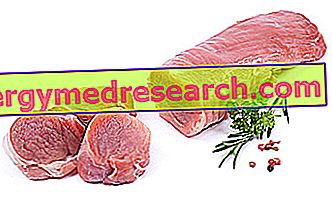Generality
The term flatulence describes a condition characterized by an excessive synthesis of gas at the gastrointestinal level, accompanied by an abnormal emission of the same gases from the rectum.

Although intestinal fermentation is an absolutely physiological phenomenon, the excessive production of gas that characterizes flatulence is often accompanied by an annoying or painful abdominal distension (meteorism), especially when, for physiological or social reasons, such gases cannot find outburst.
CURIOSITY: the noise commonly associated with flatulence is caused by the vibration of the anal opening.
Some people manage to control the sphincter that normally closes this orifice and, by reducing the abdominal pressure, sucking air into the rectum through the anus. This is the case of the famous Joseph Pujol who, more than a century ago, animated the night life of the Parisian Belle Epoque with a musical show based on raspberries. This peculiar ability earned him the nickname "le Petomane" .
Causes
Flatulence recognizes several possible causal agents. Below is a list of the main ones.
- Aerophagy : excessive swallowing of air, generally followed by noisy belching. It may have a pathological basis (gastroesophageal reflux, hiatal hernia, angina pectoris, dyspepsia, peptic ulcer) or behavioral (smoking and poor dietary habits, such as hasty ingestion of foods or drinks, especially carbonated).
- Excessive bacterial fermentation : in these cases flatulence is linked to the ingestion of foods rich in oligosaccharides which, not being completely digested, arrive in the colon, where they constitute the energy substrate of the local microflora. These micro-organisms synthesize gaseous waste products, mainly composed of: hydrogen, oxygen, carbon dioxide, methane, nitrogen and malodorous cans, sulfur, indole and butyric acid. Even excess bran can lead to flatulence and abdominal tension.
If flatulence is not associated with pathologies or frequent eructations, it is probably due to excessive bacterial fermentation. In these cases we speak of pure hyperflatulence.
- Pathologies : gastritis, peptic ulcer (gastric or duodenal), hiatal hernia, colitis, irritable bowel syndrome, syndrome of bacterial contamination of the small intestine and food allergies, but also emotional disorders and psychic disorders (anxiety, depression and stress excessive).
To learn more, read: Flatulence - Causes and Symptoms »
Diagnosis
How to recognize flatulence
As anticipated, flatulence is generally linked to the composition of the diet, more rarely it is accompanied by important pathologies. For this reason, diagnostic investigations are generally useless and the problem vanishes with simple diet therapy.
When flatulence creates important discomforts in the social context or severe pain caused by excessive gas accumulation, an accurate diagnostic investigation can still be useful.
- First of all an accurate anamensi of the patient is necessary, for example investigating if the flatulence:
- it is associated with the consumption of particular foods or certain psychological conditions
- if it is accompanied by other symptoms such as alterations in the face (constipation, diarrhea), abdominal pain or faecal mucus and blood loss
- if it is associated with the use of particular drugs, ongoing illnesses or if there is a familiarity with certain pathologies
- Thanks to an accurate medical history of the patient, at this point the doctor can hypothesize the origin of flatulence, for example:
- if it is associated with the consumption of particular foods → possible food intolerance
- if it is associated with particular eating habits (abuse of sugary drinks, sweets, starchy foods, diet low in fruit and vegetables, hyperalimentation, sedentary lifestyle) → possible loss of optimal absorption capacity of intestinal mucosa (dripping bowel syndrome or hyper- syndrome) Intestinal permeability)
- if it is associated with alterations of the bowel and states of nervousness, anxiety, stress, depression, hypochondria → possible irritable bowel syndrome
- if it is associated with fever, diarrheal discharges, severe abdominal pain → possible intestinal infection in progress
- if it is associated with diseases with an important autoimmune component (eg psoriasis, arthritis), blood in the stool, abundant mucus in the excrement, periods of constipation and other diarrhea, with alternating remissions and recurrences → possible presence of an inflammatory bowel
- if it is associated with tape-shaped stools, age> 50 years, abdominal pain, anemia and blood in the stool → possible colon tumor (malignant or benign)
- To confirm or deny these hypotheses, the doctor can subject the patient to one or more diagnostic tests
- The traditional exam consists in collecting the expelled gas through a rectal tube inserted in the anus and connected to a syringe. The chemical analysis of these gases will therefore be able to establish the origin of flatulence: if the majority constituent is the nitrogen at the base of the disorder there is probably in all probability the aerophagia; if instead the fart is rich in hydrogen and carbon dioxide it is malabsorption of carbohydrates, with consequent bacterial hyper-fermentation, as happens in lactose intolerant subjects. In any case, to be able to talk about flatulence, the number of daily expulsions must be greater than 25; the emitted gas must also exceed 100 ml / h. Instead, 10-20 passages per day are completely normal, for a total volume of about one liter of air (Bibliography: Outpatient colonproctology - treated for surgeons, gastroenterologists and practical doctors, p. 97).
- When the doctor assumes that the origin of flatulence is linked to a food intolerance, to a syndrome of bacterial contamination of the small intestine or to problems of intestinal malabsorption, he can perform the so-called breath tests, certainly more practical and used than the previous test. To learn more, we suggest reading the articles on the Breath test for the diagnosis of lactose intolerance and on the sorbitol breath test.
- Alternatively or together with the breath tests, the doctor can prescribe stool tests (eg measure of fecal pH) and blood (eg search for specific antibodies, for celiac disease)
- When the symptoms are a sign of a possible severe pathology, radiographic examinations of the gastrointestinal tract and eventually endoscopic examination (gastroscopy and / or colonoscopy) with biopsy are indicated.
It often happens that the patient attributes the origin of abdominal pain to flatulence, when in reality at the base of the disorder there is only an increased sensitivity of the colic wall (irritable bowel syndrome). Thus one has the impression that some foods cause swelling but, in effect, they stimulate not so much the flatulence, as a series of involuntary intestinal contractions, which are perceived as an annoying sense of gaseous relaxation.



